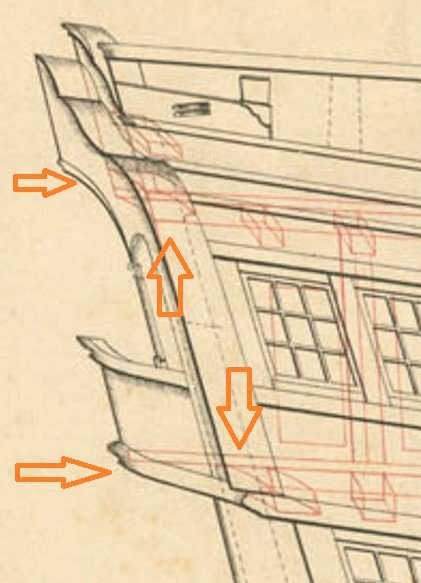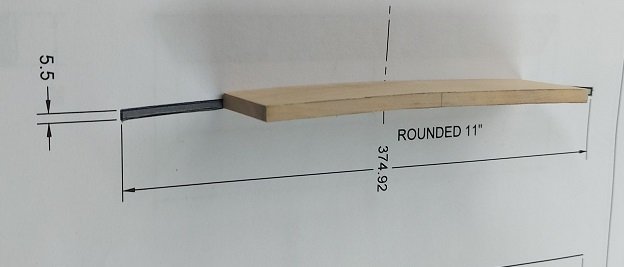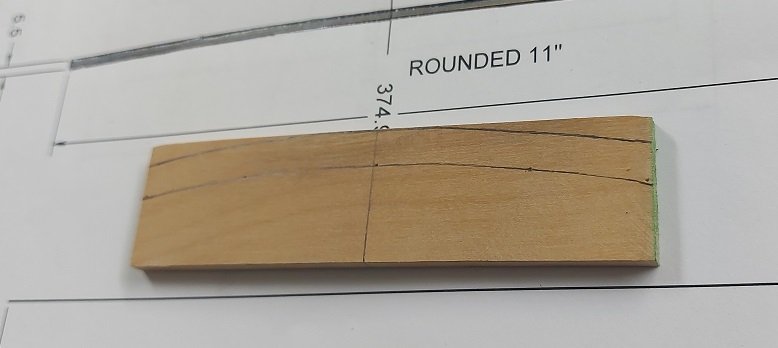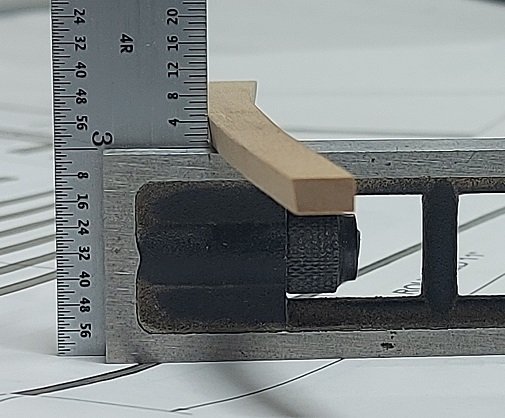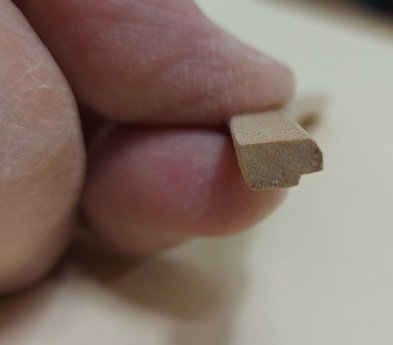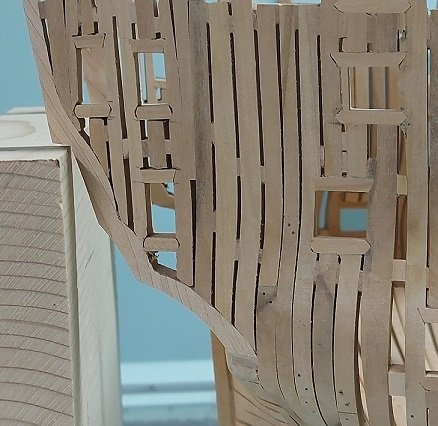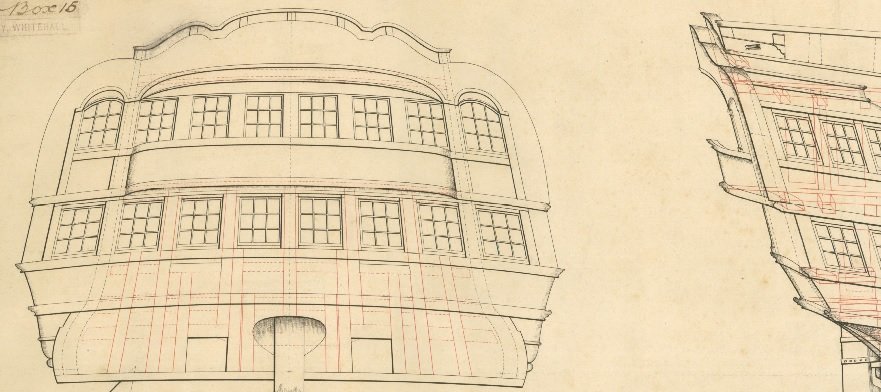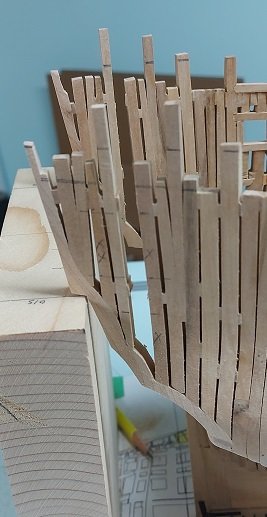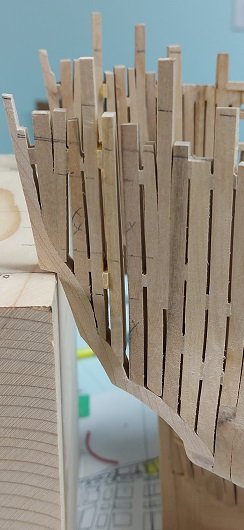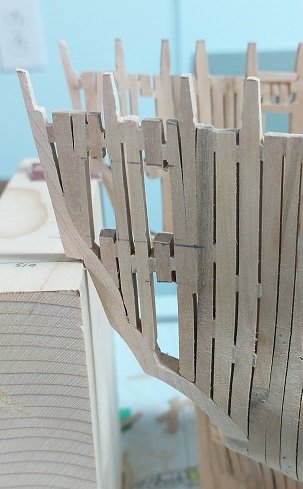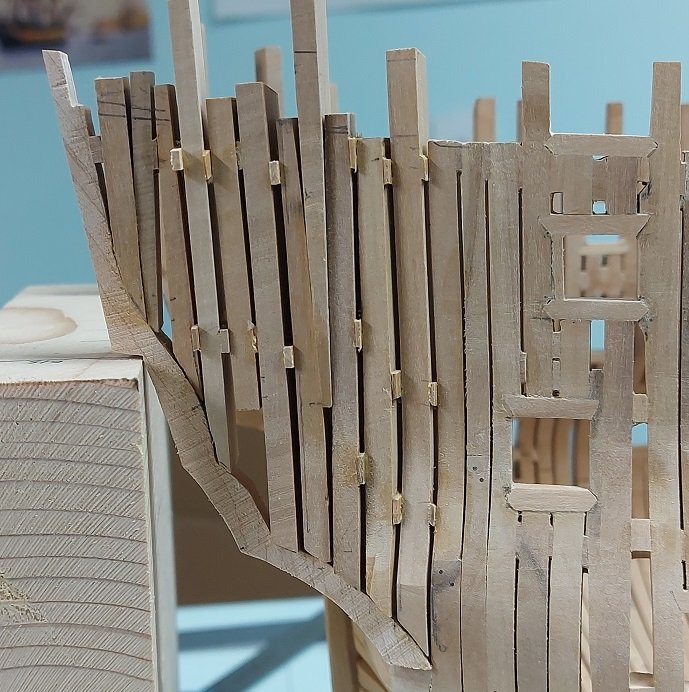-
Posts
2,840 -
Joined
-
Last visited
Content Type
Profiles
Forums
Gallery
Events
Everything posted by AON
-
I made the Roundhouse Transom beam yesterday and decided to redo the both of them as the second attempt should be better now that I'd learnt something. Below is the plan showing the transom beams. The Roundhouse (or Poop) Deck transom beam is indicated above and the Quarter Deck Transom beam is indicated below. The Round House (or Poop) Deck Transom beam is larger than the deck beams and is located so the deck planks fit in a notch below it. I began with a block of wood and traced the Round House 11" deck rise using the cardboard template I had made. Measured the height, thickness and aft rounding of the beam off the plan, multiplied by 48 then divided by 64 to get my build sizes. You can see it is double the thickness of the deck beam in the plan below it. The rise was cut out on the scroll saw and then sanded on the oscillating drum sander and finished by hand sanding The rounded back shape was drawn on the blank, cut and sanded. The deck planks are 2-1/2" thick per the contract, so I measured the distance the planks slide into it and cut the notch with my micro chisels, scraped the step out with a square mini scraper and passed some sand paper over it The aft face was bevelled to 8° to match the stern timbers by tilting the table on my disk sander and running the part over it. The forward face upper corner was rounded off with sand paper and all corners were softened similarly. The beam was longer than necessary. I made a length cutoff template with two pieces of cardboard held to overlap each other while running against the inside edge of the frames and taped them together. The beam was cut off a wee bit longer and sanded to just fit with minimum tension created by the frames springing back on it. Then I followed a similar process for the simpler Quarter Deck Transom beam. It sits below the 3" thick deck planks. Both the Roundhouse and Quarter Deck Transom pieces will need to be notched to receive the various vertical stern timbers. I am thinking I will rubber cement the transom pieces in place and then mark off the transom timbers. I have to check for the umpteenth time that I have my deck heights located properly first.
-
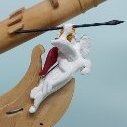
Golden Hind by Rock_From_Korea - 1:48
AON replied to Rock_From_Korea's topic in - Build logs for subjects built 1501 - 1750
Well done! -

Seats of Ease
AON replied to stuglo's topic in Discussion for a Ship's Deck Furniture, Guns, boats and other Fittings
Yup. I will dig it up this afternoon and PM you. -
Finally have the doorway cills installed. What a pain in the butt that was! Not very clean looking.... but my best effort. Now I am trying to imagine how to make the beams that go across the stern (side to side) as they curve outwards (aft) and have a curve upwards (rise in the deck) and are notched. The notches are for the vertical stern beams that are sloped aftwards making the notches sloped.
-
Well that got your attention! I have a hard maple wooden frame 24" x 30" with four corner tongue and groove joints. They were glued with yellow PVA carpenters wood glue. I had to take them apart so I wrapped the corners in cloth, soaked the cloth with 91% Isopropyl (rubbing) alcohol and wrapped that in plastic wrap so the alcohol would not evaporate. Left it overnight. Next morning each joint came apart easily. Cleaned the joints of residual glue and dry fitted them back together. The tongues are 3/16"shorter when they were originally flush to the outside of the grooves. This logically seems like shrinkage... due to the Isopropyl alcohol(?) I have not experienced this before in model building as the parts are so small (not 24" x 30") so I guess it was simply not noticeable. I soaked the tongues in water and left them 24 hours. Now they are each about 1/8" short. Has anybody experienced this before? How long will it take to recover? Will it recover?
-

Seats of Ease
AON replied to stuglo's topic in Discussion for a Ship's Deck Furniture, Guns, boats and other Fittings
Speaking of punishment, I was surprised to read a paper explaining that punishments were not immediate. Charges would be laid but the "trial" would be days, or weeks afterwards, giving the offender ample time to think about it. Then when the trial was over and punishment awarded (what a strange term for it) there would be another delay of weeks or months afterwards. I also read that the cat-o-nine tails was tied by the offender and used on him for his punishment alone. It rarely tore up the skin as depicted on movies but did leave the fellow severely battered and bruised.... I imagine akin to going too many rounds with a prize fighting boxer but your hands are tied to upright standing grating so you cannot fight back! Not something I'd want to test and prove. I had enough as a youngster having to go fetch my fathers wide leather belt and getting my own version metered out too many times on my bottom. I was a troublesome lad, but grew out of it. -
How does this differ from the boxed borax powder bought off the shelf at the grocery store in the laundry detergent aisle? Other than the obvious pressed cone shape. Maybe it has to do with the way you use it?
- 1,102 replies
-

Seats of Ease
AON replied to stuglo's topic in Discussion for a Ship's Deck Furniture, Guns, boats and other Fittings
As mentioned... the crew outnumbered the seats of ease and when the weather was too bad or the line too long and they couldn't wait their turn or there was no room in the open grating they went below and "added to the ballast". This was a chargeable offence so they had to be stealthy and quick about it. Cleaning the bilges was a regular occurrence as the excrement would muck up the pumps. I cannot imagine the disgust of the Captain seeing this flow out of a pump and across the deck. -
I find it interesting how you reduced the sail area... lowering the head, as I had seen this once before where the fellow scalloped the foot. The end result is all that matters, and yours look pretty darned good! Well done. You taught me something today. Thank you. I imagine play rope snugging tag is as much fun as you make it out to be
- 366 replies
-
- bellerophon
- victory models
-
(and 2 more)
Tagged with:
-
post a question in a forum topic like this one: https://modelshipworld.com/forum/17-model-tips-and-tricks-and-making-jigs/ and ask for help on how to properly clean dust a model. There is a technique with Q-tips, saliva, elbow grease and lots of time used by professionals. Some might suggest how to safely do a first stage cleaning. I've not done it, only been told and read about it and physically seen the before and results after.
-
Forgive my ignorance but I cannot see anything other than it needing a damn good cleaning and a dust protective display case. I also think that if you like it, it is worth every bit of energy you are willing to put into it to bring it to the state you wish it were at. I for one like it very much. Great eye and good recovery (from the dump). In my home town dump they would have tackled me and fined me, then took the model and try to sell it! 😁
-

Mariner's Astrolabe, full scale, AON
AON replied to AON's topic in CAD and 3D Modelling/Drafting Plans with Software
Here are some drawings I made this morning. I will email them to Bob. As I have the free hobbyist version of Fusion 360 there are things it will not let me do so some overall dimensions (from a corner of the object to the extreme end of a radius ) are missing. My copper pins were from standard house wiring (16 or 12 gauge, not sure at the moment) and the alidade (pointer), hub, and retainer cap were sanded to fit together as a friction fit. The pointer stays where it is pointing, it does not swivel freely. If I were doing this again I'd make the pointer a wee bit longer and my embossed number angle) a wee bit larger. Mariner's Astrolabe Body.pdf Mariner's Astrolabe Alidade.pdf Mariner's Astrolabe Cap.pdf Mariner's Astrolabe Upper Swivel + Ring.pdf Mariner's Astrolabe Lower Swivel.pdf- 36 replies
-
- Navigation
- Instrument
-
(and 1 more)
Tagged with:
-

Mariner's Astrolabe, full scale, AON
AON replied to AON's topic in CAD and 3D Modelling/Drafting Plans with Software
Hello Bob, You missed a good Model Shipwrights of Niagara meeting yesterday. Would you be building yours in metal (brass or copper plate)? What size paper can you print on? I can make a full size 2D drawing of a front view and side view of my model quite easily and will send it to you after I discover more of what you intend and can print.- 36 replies
-
- Navigation
- Instrument
-
(and 1 more)
Tagged with:
-
Got most of the sanding done today. Decided to mark off the top timbers and cut those back and mark off and install the gallery side doors to the officers toilets (seats of ease) and get those done (install the cills) before I complete the sanding. While marking the timbers for the doorways I discovered I had one short adjacent timber located improperly... it needed to be the next one over. I suppose I should have triple checked. So I need to remove that pair (port and starboard or larboard if we're being correct for the period) and reinstall longer timbers before I cut any doorways. I will post a photo when I'm done.
About us
Modelshipworld - Advancing Ship Modeling through Research
SSL Secured
Your security is important for us so this Website is SSL-Secured
NRG Mailing Address
Nautical Research Guild
237 South Lincoln Street
Westmont IL, 60559-1917
Model Ship World ® and the MSW logo are Registered Trademarks, and belong to the Nautical Research Guild (United States Patent and Trademark Office: No. 6,929,264 & No. 6,929,274, registered Dec. 20, 2022)
Helpful Links
About the NRG
If you enjoy building ship models that are historically accurate as well as beautiful, then The Nautical Research Guild (NRG) is just right for you.
The Guild is a non-profit educational organization whose mission is to “Advance Ship Modeling Through Research”. We provide support to our members in their efforts to raise the quality of their model ships.
The Nautical Research Guild has published our world-renowned quarterly magazine, The Nautical Research Journal, since 1955. The pages of the Journal are full of articles by accomplished ship modelers who show you how they create those exquisite details on their models, and by maritime historians who show you the correct details to build. The Journal is available in both print and digital editions. Go to the NRG web site (www.thenrg.org) to download a complimentary digital copy of the Journal. The NRG also publishes plan sets, books and compilations of back issues of the Journal and the former Ships in Scale and Model Ship Builder magazines.


